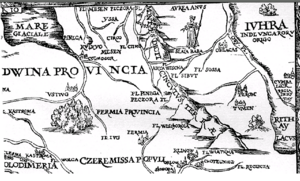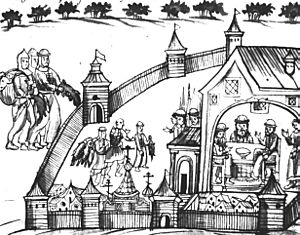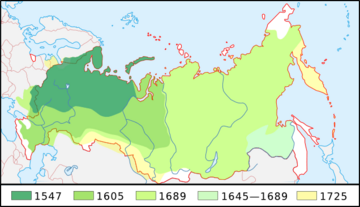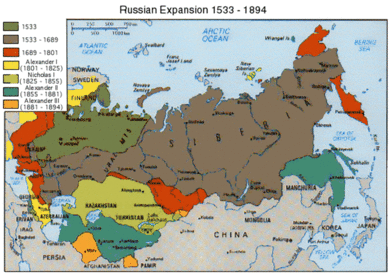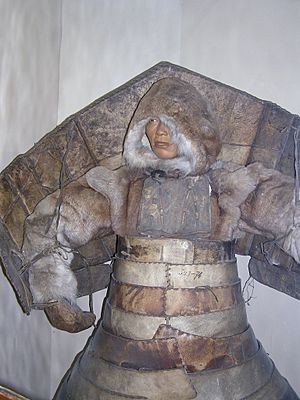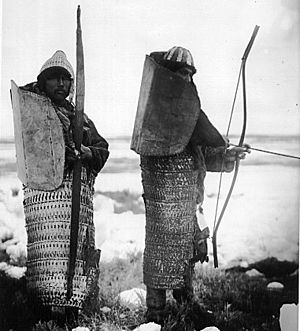Russian conquest of Siberia facts for kids
Quick facts for kids Russian conquest of Siberia |
|||||||||
|---|---|---|---|---|---|---|---|---|---|
| Part of the territorial evolution of Russia | |||||||||
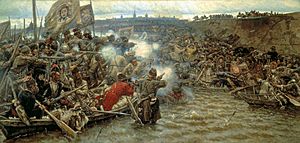 Yermak's Conquest of Siberia, a painting by Vasily Surikov |
|||||||||
|
|||||||||
| Belligerents | |||||||||
Allied indigenous Siberians |
Khanate of Sibir (until 1598) Daurs Bashkirs Yakuts Koryaks Chukchis |
||||||||
| Commanders and leaders | |||||||||
| Kuchum Khan Daur prince Guigudar |
|||||||||
The Russian conquest of Siberia was a long period from 1580 to 1778. During this time, Russia expanded its control over the vast lands of Siberia. The Khanate of Sibir was a loose group of smaller states. Russian explorers slowly weakened these states. Even though the Russians were often outnumbered, they convinced many local tribes to change their loyalty. They also built forts far away and launched attacks from them.
The conquest is usually thought to have started in 1580 with Yermak Timofeyevich's campaign against the Siberian Khanate. Local people in Siberia and the Far East fought against Russia taking over their lands. There were many fierce battles between the local peoples and the Russian Cossacks.
Contents
Taking Over the Khanate of Sibir
The Russian takeover of Siberia began in July 1580. About 540 Cossacks led by Yermak Timofeyevich entered the land of the Voguls. These people were under the rule of Kuchum Khan, who led the Sibir Khanate. Some soldiers from Lithuania and Germany, who were prisoners of war, also joined them.
In 1581, this group traveled through an area called Yugra. They took control of towns belonging to the Vogul and Ostyaks people. They also captured a tax collector who worked for Kuchum Khan.
After some attacks by Tatars against the Russian advance, Yermak's forces got ready to capture Qashliq. This was the capital city of Siberia. Their journey began in May 1582. After a three-day battle near the Irtysh River, Yermak won. He defeated a combined army of Kuchum Khan and six Tatar princes. On June 29, the Tatars attacked the Cossack forces again, but the Cossacks pushed them back.
In September 1582, Kuchum Khan gathered his armies to defend Qashliq. Many Siberian Tatars, Voguls, and Ostyaks gathered at Mount Chyuvash. They wanted to defend against the invading Cossacks. On October 1, the Cossacks tried to storm the Tatar fort at Mount Chyuvash but were stopped. On October 23, the Cossacks tried to storm the fort for a fourth time. The Tatars fought back hard. More than a hundred Cossacks were killed. But the Cossacks' guns forced the Tatars to retreat. This allowed the Cossacks to capture two Tatar cannons. Kuchum Khan's forces left, and Yermak entered Qashliq on October 26.
Kuchum Khan went into the steppes and spent the next few years rebuilding his army. On August 6, 1584, he suddenly attacked Yermak in the middle of the night. He defeated most of Yermak's army. The details are not fully clear. Russian stories say Yermak was hurt and tried to escape by swimming across the Wagay River. This river flows into the Irtysh River. But he drowned because of the heavy weight of his chain mail armor.
The rest of Yermak's forces, led by Mescheryak, left Qashliq. They destroyed the city as they went. In 1586, the Russians came back. They used their cannons to take control of the Khanty and Mansi people. They then built a fort at Tyumen, near the ruins of Qashliq.
The Tatar tribes who followed Kuchum Khan were attacked by the Russians many times between 1584 and 1595. But Kuchum Khan was never caught. Finally, in August 1598, Kuchum Khan was defeated at the Battle of Irmen. This battle was near the Ob River. During the fight, the Siberian royal family was captured by the Russians. However, Kuchum Khan escaped once more. The Russians took Kuchum Khan's family members to Moscow. They stayed there as hostages. The family members of the khan became known as the Princes Sibirsky. This family is known to have existed until at least the late 1800s.
Even though Kuchum Khan escaped, his family's capture ended his political and military actions. He went to the lands of the Nogai Horde in southern Siberia. He had talked with the tsar (the Russian ruler) and asked for a small area along the Irtysh River to be his own. The tsar said no. He suggested that Kuchum Khan come to Moscow and "comfort himself" by serving the tsar. But the old khan did not want to be treated with such disrespect. He preferred to stay in his own lands rather than "comfort himself" in Moscow. Kuchum Khan then went to Bukhara. As an old man, he became blind. He died in exile with distant relatives around 1605.
Russian Expansion and Exploration
To control the local people and collect yasak (a tax paid in furs), Russians built many winter outposts (called zimovie) and forts (called ostrogs). These were built where major rivers met or at important places where boats could be carried over land. The first of these were Tyumen and Tobolsk. Tyumen was built in 1586 by Vasilii Sukin and Ivan Miasnoi. Tobolsk was built the next year by Danilo Chulkov. Tobolsk became the main center for the conquest.
To the north, Beryozovo (1593) and Mangazeya (1600–01) were built. These were meant to make the Nenets pay tribute. To the east, Surgut (1594) and Tara (1594) were set up. These protected Tobolsk and helped control the ruler of the Narym Ostiaks. Mangazeya was very important. It became a base for exploring further east.
Moving up the Ob River and its smaller rivers, the forts of Ketsk (1602) and Tomsk (1604) were built. Soldiers from Ketsk reached the Yenisei in 1605. They traveled down it to the Sym. Two years later, fur traders from Mangazeya traveled down the Turukhan to where it met the Yenisei. There, they built the winter outpost Turukhansk. By 1610, men from Turukhansk had reached the mouth of the Yenisei. They traveled up it as far as the Sym, where they met other groups collecting tribute from Ketsk. To make sure the local people were controlled, the forts of Yeniseysk (1619) and Krasnoyarsk (1628) were built.
After the khan's death and the end of organized Siberian resistance, the Russians moved towards Lake Baikal. Then they went to the Sea of Okhotsk and the Amur River. However, when they first reached the Chinese border, they met people who had cannons. This made them stop.
The Russians reached the Pacific Ocean in 1639. After the Siberian Khanate was taken over (in 1598), all of North Asia became known as Siberia. This area was much larger than the old khanate. By 1640, Russia's eastern borders had grown by millions of square kilometers. The title "Tsar of Siberia" became part of the full title for Russian rulers.
The conquest of Siberia also led to the spread of diseases. Historian John F. Richards wrote that the total Siberian population in early modern times was likely not more than 300,000 people. New diseases made the indigenous peoples of Siberia weaker and less hopeful. The worst disease was smallpox. It spread quickly, caused many deaths, and left survivors with lasting marks. In the 1650s, smallpox moved east of the Yenisey River. It caused up to 80 percent of the Tungus and Yakut people to die. In the 1690s, smallpox outbreaks reduced the Yukagir population by about 44 percent. The disease moved fast from one group to another across Siberia.
Effects on Local Peoples
When the Cossacks' requests were turned down, they used force. Under leaders like Vasilii Poyarkov in 1645 and Yerofei Khabarov in 1650, many people were killed by the Cossacks. This included members of the Daur tribe. In Kamchatka, only 8,000 people remained out of a previous population of 20,000 after the first 50 years of Russian control. The Daurs first left their villages because they feared the reported harshness of the Russians when Khabarov first came. The second time he came, the Daurs fought back against the Russians, but many were killed. In the 1600s, local people in the Amur region were attacked by Russians, who became known as "red-beards."
In the 1640s, the Yakuts faced violent attacks as the Russians moved into the land near the Lena River. In Kamchatka in the 1690s, the Koryaks, Kamchadals, and Chukchi also faced similar situations from the Russians, according to historian Stephen Shenfield. In the Lena basin, 70% of the Yakut population decreased within 40 years. Native women and children were sometimes forced to work to make the local people pay the yasak.
In Kamchatka, the Russians stopped the Itelmen uprisings against their rule in 1706, 1731, and 1741. The first time, the Itelmens had stone weapons and were not well prepared. But they used gunpowder weapons the second time. The Russians faced stronger resistance from 1745 to 1756. They tried to control the Koryaks, who had guns and bows, until they won. The Russian Cossacks also faced fierce resistance and had to give up when they tried unsuccessfully to defeat the Chukchi in 1729, 1730–1731, and 1744–1747.
After the Russian defeat in 1729 by the Chukchi, the Russian commander Major Pavlutskiy was in charge of the Russian war against the Chukchi. He was responsible for many deaths and forcing Chukchi women and children to work in 1730–1731. But his harshness only made the Chukchis fight even harder. Empress Elizabeth ordered in 1742 that the Chukchis and Koryaks be "totally removed" from their lands and their culture erased through war. The order was that the local people be "totally wiped out." Pavlutskiy led this war again from 1744–1747. He led the Cossacks to kill Chukchi men and force their women and children to work. However, the Chukchi ended this campaign and made them give up by killing Pavlutskiy.
The Russians also started wars against the Koryaks in 1744 and 1753–1754. After the Russians tried to force the local people to change to Christianity, different native peoples like the Koryaks, Chukchis, Itelmens, and Yukaghirs all joined together. They wanted to drive the Russians out of their land in the 1740s. This led to an attack on Nizhnekamchatsk fort in 1746.
Today, Kamchatka's population is mostly European in culture. Only about 5% are native people, around 10,000 from a previous number of 150,000. This is due to the many deaths caused by the Cossacks after Kamchatka was taken over in 1697. This happened to the Itelmens and Koryaks during the first few decades of Russian rule. The killings by the Russian Cossacks greatly affected the native peoples of Kamchatka. Besides causing deaths, the Cossacks also harmed wildlife by killing many animals for fur. 90% of the Kamchadals and half of the Vogules died from the 1700s to 1800s. The rapid decline of the local population led to entire ethnic groups disappearing. Around 12 groups were wiped out, as noted by Nikolai Yadrintsev in 1882. Much of this was caused by the Siberian fur trade.
Russian people in Siberia in the 1800s, known as oblastniki, admitted that the local people were treated very harshly. They said they would fix the situation with their suggested regional policies.
The Aleuts in the Aleutians faced harsh treatment and forced labor by the Russians for the first 20 years of Russian rule. Aleut women and children were captured, and Aleut men were killed.
The Russian colonization of Siberia and its local peoples has been compared to the European colonization of the Americas. Both had similar negative effects on the native people and involved taking their land. Slavic Russians now outnumber all the native peoples in Siberia and its cities. The only exceptions are the Republics of Tuva and Sakha. Slavic Russians make up the majority in the Buryat and Altai Republics, outnumbering the Buriat and Altai natives. The Buryats are only 33.5% of their own Republic, the Altai 37%, and the Chukchi only 28%. The Evenk, Khanty, Mansi, and Nenets are outnumbered by non-natives by 90% of the population. The native people were targeted by the tsars and Soviet policies to change their way of life. Ethnic Russians were given the natives' reindeer herds and wild game, which were taken by the tsars and Soviets. The reindeer herds have been managed poorly, almost to the point of disappearing.
The Ainu have said that they were the original people of the Kuril Islands. They believe that both the Japanese and Russians were invaders.
Timeline of the Conquest
16th Century: Taking Over Western Siberia
- 1581-1585 - The Siberian campaign of Ermak Timofeevich.
- 1586 - Vasily Sukin founded Tyumen. This was the first Russian city in Siberia, built where the Siberian Khanate's capital used to be.
- 1587 - Tobolsk was founded on the Irtysh River. It later became known as the "Capital of Siberia."
- 1590 - The first order was given to move Russian people to Siberia. 35 "farming people" from Solvychegodsk district were sent to settle in Siberia with their families and belongings.
- 1593 - Berezov was founded.
- 1594 - Surgut and Tara were founded.
- 1595 - Obdorsk was founded.
- 1598 - The Piebald Horde was conquered, and Narym was founded.
- 1598 - Battle of Irmen, the final conquest of the Siberian Khanate.
17th Century: From the Yenisei to the Pacific Ocean, and Conflicts with China
- 1601 - Mangazeya was founded to control the West Siberian Samoyeds.
- 1604 - Tomsk was founded as a fort against the Dzungars and the Yenisei Kirghiz.
- 1607 - Turukhansk was founded. It was the first city on the Yenisei River. The Enets people were conquered.
- 1618 - Kuznetsk was founded.
- 1619 - Yeniseisk was founded.
- After 1620 - An unknown expedition to Taimyr was unsuccessful. Evidence was found in Simsa Bay and the Thaddeus Islands.
- 1623 - Pyanda first reached the Lena River in the Kirensk area.
- 1628 - Governor Andrey Dubensky founded Krasnoyarsk on the Yenisei. Kansky Ostrozhek was founded.
- 1630 - Vasily Bugor founded Kirensk on the Lena. Ivan Galkin founded the Ilim winter hut.
- 1631 - Ataman Maxim Perfilyev founded the Bratsk prison on the Angara River. The Ust-Kutsk prison was founded.
- 1632 - Pyotr Beketov founded Yakutsk and Zhigansk. Two years later, the Yakuts defeated a Cossack group led by Ivan Galkin on the Lena. They then surrounded Yakutsk. This counterattack by the local people was largely due to fighting between Cossack groups (from Mangazeya and Yenisei) over collecting yasak.
- 1633 - Ivan Rebrov discovered the mouth of the Lena and the Yana River.
- 1638 - The Yakut Voivodeship was created. The cavalry campaign of centurion Ivanov went to Indigirka against the Yukaghirs.
- 1638 - An expedition by Peter Golovin and Efim Filatov went to the Lena River to build a prison.
- 1639 - Kopylov sent a group led by Ivan Moskvitin to the Sea of Lamsky.
- 1643 - Ataman Vasily Kolesnikov reached Lake Baikal. Meanwhile, Mikhail Stadukhin reached Kolyma.
- 1643 - Vasily Poyarkov's expedition went to the Amur region (Dauria). They traveled down the Amur to the Sea of Okhotsk.
- 1644-1645 - A campaign by the Cossacks against the Buryats in the Angarsk Steppe.
- 1646 - Vasily Poyarkov's expedition: a campaign from Yakutsk to the Sea of Okhotsk.
- 1647 - Ivan Moskvitin founded Okhotsk.
- 1648 - Semyon Dezhnev passed through the Bering Strait. He was the first European to do so, 80 years before Vitus Bering.
- 1648-1653 - Yerofey Khabarov's campaigns in Dauria.
- 1649-1689 - Conflicts between Russia and Qing China over borders.
- 1652 - Battle of Achan prison.
- 1653 - Chita and Nerchinsk were founded in Transbaikalia.
- 1655 - Siege of Kumar prison.
- 1661 - Irkutsk was founded on the Angara River by Yakov Pokhabov.
- 1665 - Selenginsky prison was founded by Gavrila Lovtsov on the Selenga River.
- 1666 - On the Uda River, where it meets the Selenga, the Uda winter hut was founded. It later became known as the Uda jail.
- 1685-1686 - Siege of Albazin.
- 1686 - An unsuccessful attempt to explore Taimyr by Ivan Tolstoukhov. The expedition went missing.
- 1689 - China and Russia signed the Treaty of Nerchinsk.
- 1692 - An expedition of Russian service people against the Yenisei Kirghiz. The Tubinsky ulus was defeated. Up to 700 Kirghiz were killed in the battle.
- 1697-1698 - Kamchatka was taken over by the expedition of Vladimir Atlasov.
- 1699 - When returning to the Anadyr prison, the Seryukov group was destroyed.
18th Century: Taking Over Chukotka and Kamchatka
- 1703-1715 - An uprising in Kamchatka against the Russians. During this time, the Bolsheretsky and Aklansky prisons were burned. About 200 Cossacks were killed. In 1705, the Koryaks destroyed a Cossack group led by Protopopov. In 1715, the Russians took the largest Koryak settlement, Bolshoy Posad.
- 1709 - Bikatun prison was set up in the foothills of Altai.
- 1711 - Danila Antsiferov discovered the Kuril Islands.
- 1712 - A revolt and murder of their chiefs (Atlasov, Chirikov, and Mironov) by the Cossacks in Kamchatka.
- 1712 - Mercury Vagin discovered the New Siberian Islands.
- 1716 - Omsk was founded.
- 1730s-1740s - Trips to Chukotka. Military expeditions of Russian groups led by Pavlutsky.
- 1733-1743 - The Great Northern Expedition explored the Siberian coast of the Arctic Ocean (Khariton Laptev, Semyon Cheyuskin). The empty Taimyr region was explored. The mountains of Byrranga and Cape Chelyuskin (the northern tip of Siberia) were discovered.
- 1740 - Petropavlovsk-Kamchatsky was founded.
- 1747 - The Chukchi destroyed the group of the Anadyr commandant.
- 1748-1755 - Seven military campaigns against the Chukchi.
- 1752 - The Gizhiginskaya fortress was founded.
- 1753 - The Koryaks surrounded the Gizhiginskaya fortress.
- 1778 - The final annexation of Chukotka.
Why Russia Expanded
The main reason Russia felt it had the right to expand into Siberia was based on an idea. They believed that when the Khanate of Sibir became part of Russia, Russia gained legal control over all the land from the Ural Mountains to the Pacific Ocean in the east. So, the actual borders of Siberia were not very clear. Russian control over the land only stopped when Russia's claims met strong states that could fight back, like China and Mongolia.
Another reason for Russian expansion was to spread Eastern Orthodox Christianity. However, this idea mostly came from the explorers and settlers themselves as a reason for their actions, rather than being a main goal set by the Russian Orthodox Church.
|
See also
 In Spanish: Conquista rusa de Siberia para niños
In Spanish: Conquista rusa de Siberia para niños
- List of Russian explorers
- Russian irredentism
- Sino-Russian border conflicts
- Siberian regionalism


